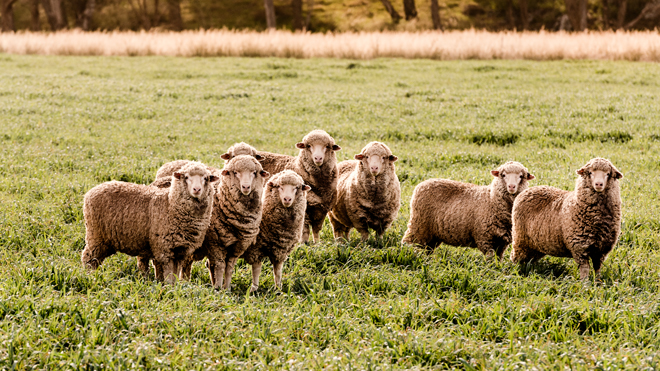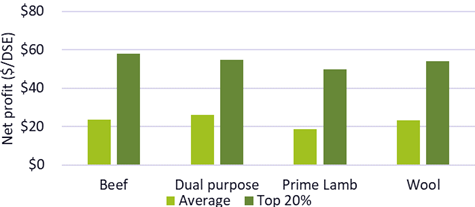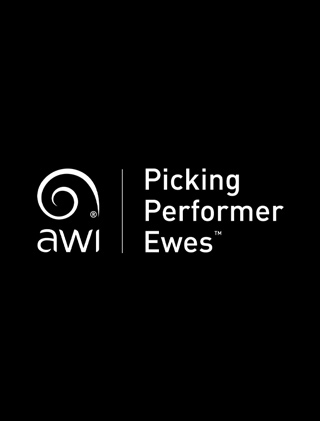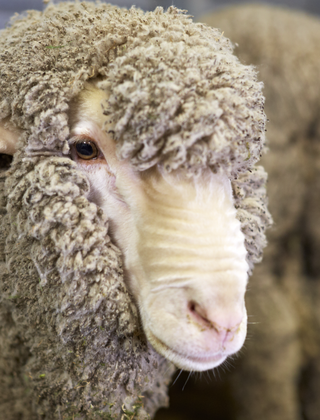New report provides reasons to stay in wool

According to a recent analysis of livestock enterprise profitability, specialist wool enterprises have delivered similar or superior profits compared to other livestock enterprise types over a five-year period, and changing enterprises is unlikely to deliver higher profitability for producers.
KEY POINTS IN THE REPORT
- Over the five-years 2018-19 to 2022-23, wool sheep enterprises provided similar or better profits than alternative livestock enterprises.
- Switching to a different enterprise type is unlikely to deliver greater profits for producers. Improving performance within an existing enterprise is more likely to increase profits than moving between enterprises.
- Measuring the financial and production performance of an enterprise is an important way to identify ways to achieve the greatest rewards from the lowest cost; in particular, it is vital to examine the feed supply curve and align it to livestock energy demands over the year.
- Potential opportunities to deliver higher production at low marginal cost include simplifying the operations of the enterprise, improving infrastructure to deliver higher levels of labour efficiency, and investing in genetics.
If you are a woolgrower experiencing low margins in the current economic climate, changing your enterprise based on a perception that alternative enterprises would deliver higher profitability might sound tempting. But think again. A report released in August shows that wool enterprises have actually delivered solid operating profits when compared to other breeding livestock enterprises over the last five years.
Furthermore, the report demonstrates that producers are more likely to derive greater profits by improving performance within their existing enterprise rather than changing enterprise.
Released at the end of August, the report, titled Why stay in wool sheep?, was commissioned by AWI and produced by John Francis, Director of the highly respected agricultural consultancy company Agrista.
Enterprise level financial data from the Agrista benchmarking database for the five years 2018-19 to 2022-23 was used to assess variability in economic performance of four livestock breeding enterprise types: beef breeding herds, dual purpose sheep flocks, prime lamb flocks and wool flocks. The data was collected from mixed enterprise farm managers primarily located in eastern Australian states. More detail about the data used in the analysis is available in the report.
This Beyond the Bale article summarises some of the key points from the report.
Relative financial performance of wool enterprises
Variations in prices and seasonal conditions were significant during the examined five-year period, which benefited or hindered different enterprise types in specific years. All enterprise types experienced big swings year on year.
However, the annual variations in enterprise type performance disappeared over a longer timeframe (i.e. a five-year period). Figure 1 below shows the five-year average net profit of the four enterprise types, plus the top 20% performing enterprises for each enterprise type.
Figure 1: Five-year average profits for four different enterprise types

The chart shows that specialist wool enterprises have delivered similar or superior profits when compared with alternative enterprise types.
The greatest difference between enterprise types is $7.30 per DSE, which is the difference between the dual purpose sheep and prime lamb enterprises. However, this between-enterprise difference is small when compared with the difference of approximately $30 per DSE seen in all enterprise types between the average and the top 20% performing enterprises.
The variability within enterprise exceeds the variability between enterprise by an approximate magnitude of more than four times in most enterprises.
This suggests that, where the producer’s aim is to improve financial performance over the medium or long term, the primary focus should be on enhancing the results of their existing enterprise rather than moving between enterprises. In other words, it is likely there is more to be gained by getting better at their current enterprise than changing enterprise.
“Improving what you know delivers more value than moving to what you don't.”
John Francis, Director of Agrista
What do the best woolgrowers do differently?
Using long-term comparative analysis, one of the key features of highly profitable wool enterprise managers is that they typically deliver far more production and superior profits per hectare but only marginally greater production and profit per DSE.
Examination of these high profit wool enterprises in south-eastern Australia shows that the primary difference between these managers and the remainder is higher levels of feed utilisation. In these localities, approximately 60 per cent of the pasture supply occurs during 25 to 50 per cent of the year so implementing a livestock system that has high energy demands over this period is important.
The key output of higher relative feed utilisation is higher relative stocking rate. This delivers higher profitability by increasing the margin on each kilogram of wool and sheep meat produced. It does this by delivering cost efficiency by spreading the overhead cost structure over more wool and sheep meat production.
High levels of feed utilisation are unattainable with a system that does not match feed supply with feed demand. The simplest of systems changes typically comes from aligning lactation with a period of high supply and quality of pasture, and reducing ewe energy demands to maintenance during the period of the year when pasture energy and supply are low.
Supplementary feed costs are also a feature of these high profit livestock enterprises. The supplementary feed serves the purpose not only of supporting the appropriate number of livestock moving into the period of high energy supply, but it also delivers the difference between the pasture energy deficit and the energy demands of the flock as pasture energy declines. Feed for the energy deficit is necessary irrespective of the level of feed utilisation of the manager.
The cost structure per DSE of high profit livestock producers is typically lower than the remainder. This difference occurs due to superior labour efficiency and the spreading of the overhead cost structure over more production.
Genetics plays a large role in improving productivity by delivering greater wool and meat value per unit of energy consumed. The value of the contribution of genetics is not easily discernible from wool enterprise data, however general observations of the high profit cohort suggest that these producers invest heavily in this area.
“There are large opportunities to improve wool flock profits even when wool prices are low, but they require a change to conventional thinking. You can start by measuring financial and production performance to identify the greatest rewards from the lowest cost".
John Francis, Director of Agrista
Streamlined operations to reduce complexity
Another feature of highly profitable livestock managers is their ability to streamline operations to deliver simplicity. Examples include single lambing dates within the year, single shearing dates within year, the joining of ewes as hoggets and the inclusion of multiple age groups of wethers to reduce the number of weaners that must be managed.
Practical tip: Assess the operational calendar and establish whether there are multiple activities occurring with limited or no marginal benefit. Develop an operational calendar and see whether there are handling operations that could be combined to reduce unnecessary work.
Reduced workload and physical demands
Some infrastructure and sheep handling investments have been shown to significantly improve labour efficiency while potentially delivering high returns on investment. Examples include laneways, sheep handlers and lifters, covered work areas, and sprinklers for dust suppression. Many of these investments also serve the purpose of attracting or retaining staff and making tasks less physically demanding or more pleasant.
Practical tip: Conduct an audit of infrastructure and handling equipment and apply a rating from 1 (near new) to 5 (needs replacing). Consider equipment for which small investments or repairs could make large differences to labour efficiency or workplace enjoyment.
“Simplifying operations and examining infrastructure for opportunities to delivering higher levels of labour efficiency will go a long way to improving enterprise profitability and satisfaction.”
John Francis, Director of Agrista
Changing enterprises has its costs
In addition to considering the relative profitability of enterprise types, it is also important to note that there are costs incurred by actually changing enterprise type. These costs are often not considered with adequate attention because they are difficult to quantify. Of note:
- Skill development takes time: Switching enterprises requires investment in understanding the profit drivers of a different enterprise and the development of new skills.
- Performance lag leads to lower profits: Peak efficiency in a new enterprise is unlikely to occur instantly. There is usually a lag.
- Infrastructure and genetic investment: The requirement for capital can be significant. Investment analysis shouldn’t just value the marginal benefits but also the up-front capital costs. Genetics, infrastructure and plant are usually the big ticket items.
Given the extreme cost of changing enterprise, woolgrowers should quantify the level of production and financial performance in their existing enterprise. This approach allows for the objective assessment of enterprise performance and identifies low cost opportunities to improve productivity and profitability within the enterprise before considering moves between enterprise.
Wool Enterprise Strengths
Diversity of income – Wool enterprises have multiple income streams including wool, sheep meat and, in some cases, lamb. This diversity in income enables woolgrowers to adapt their enterprise based on market signals, resource suitability or management preference.
Income generation during drought – Wool sheep have low maintenance energy requirements and produce a fleece of reasonable value even in a drought, meaning that the reduction in income due to drought is lower when compared to livestock enterprises dependent on meat production.
Maternal flexibility – The Merino ewe has the flexibility to be joined to a Merino to produce progeny with high capability of growing wool, or to a maternal sire, or a terminal sire, or it can be managed as a dry sheep with lower energy requirements and higher wool production relative to a lactating ewe.
The value of wethers and dry ewes – Wethers are a feed efficient animal because there is no reproductive demand for energy. These animals are well-suited to land classes with low energy feed and to environments with little seasonal rainfall pattern.
More information:
- Download the 12-page Why stay in wool sheep? report at www.wool.com/stayinwool
- View a recording of John Francis talking through the report in a webinar held in October, available at www.youtube.com/AWIWoolProduction
This article appeared in the December 2024 edition of AWI’s Beyond the Bale magazine. Reproduction of the article is encouraged.















